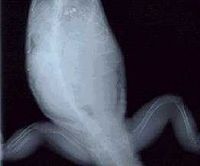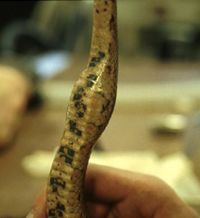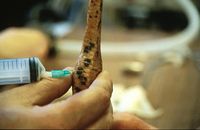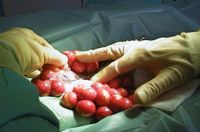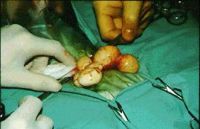Difference between revisions of "Lizard and Snake Dystocia"
| Line 70: | Line 70: | ||
Good nutrition and keeping lizards and snakes within their [[Preferred optimum temperature zone|POTZ]] will decrease the incidence of maternal causes of dystocia. Iguanas that are housed in enclosures at least 2m high and can climb up and down for eating appear to have fewer incidences of dystocia. The best prevention for dystocia is neutering. However, the adrenals must be avoided since they are suspended in the mesorchium or mesovarium | Good nutrition and keeping lizards and snakes within their [[Preferred optimum temperature zone|POTZ]] will decrease the incidence of maternal causes of dystocia. Iguanas that are housed in enclosures at least 2m high and can climb up and down for eating appear to have fewer incidences of dystocia. The best prevention for dystocia is neutering. However, the adrenals must be avoided since they are suspended in the mesorchium or mesovarium | ||
[[Category:Lizard and Snake Diseases|D]][[Category:Lizard Reproductive Diseases|D]] | [[Category:Lizard and Snake Diseases|D]][[Category:Lizard Reproductive Diseases|D]] | ||
| + | [[Category:Snake Reproductive Diseases]] | ||
Revision as of 01:57, 23 April 2010
| This article has been peer reviewed but is awaiting expert review. If you would like to help with this, please see more information about expert reviewing. |
Dystocia is common in reptiles and may affect 10% of the captive population annually. Dystocia is a relatively common problem occurring in lizards, however snakes appear to be the most susceptible.
- For information on lizard and snake anaesthesia and surgery, see Lizard and Snake Anaesthesia and Lizard and Snake Surgery.
What is Dystocia?
Dystocia is the retention of follicles or eggs in the female and is common in lizards (mainly iguanas) and snakes. Reptiles can resorb follicles that do not develop but sometimes this does not occur and pre-ovulatory follicular dystocia occurs.
Female iguanas will show anorexia for at least four weeks before oviposition but will remain bright, alert and responsive. When there is no appropriate site for oviposition the developed eggs may be retained and post-ovulatory egg stasis occurs. Sometimes a number of eggs may be retained after some have been laid and again dystocia occurs. Cloacal prolapse may be associated with retained eggs.
In snakes
Dystocia in snakes may be caused by a variety of factors and include obstructive and non-obstructive problems. Obstructive dystocia may be foetal (include oversized or malformed eggs and foetuses) or maternal (include oviduct stricture and non-reproductive masses such as abscesses). Non-obstructive problems include poor husbandry, poor physical condition and concurrent disease.
In lizards
There are two types of dystocia in iguanas - pre-ovulatory follicles (more common) and post-ovulatory eggs (in the oviduct). Surgical intervention is often required. The most common cause of dystocia in lizards is the absence of a suitable nesting site and media but other factors include:
- Poor husbandry
- Improper temperatures
- Poor or inadequate diet
- Dehydration
- Poor physical condition
Dealing with Dystocia
Examination
History may include lack of a suitable nesting site or media, poor husbandry including unsuitable temperatures and inappropriate caging. Access to a mate is not necessary. Lizards with dystocia may be lethargic, depressed, non-responsive or display unusual behaviour. They may be anorexic, dehydrated and in poor physical condition. On physical examination the coelomic cavity may be enlarged and there may be palpable round masses. Cloacal prolapse may be an associated sign.
Elaphe species are especially susceptible. Recent oviposition and the presence of a caudally located mass or masses are commonly associated with dystocia. On physical examination the masses are relatively firm and are often positioned just cranial to the cloaca. Tenesmus or cloacal prolapse may be present. The time from breeding to oviposition is generally not useful because of the difficulty in judging the time accurately.
Diagnosis
Diagnosis is based on history, clinical signs, palpation and radiography; ultrasound is useful for confirmation. Dystocia is suggested by a history of a lack of an acceptable site for oviposition and anorexia over four weeks. Clinical signs include a swollen coelomic cavity with round masses on palpation. Radiography may confirm this.
Therapy
Dystocia is usually not an emergency situation if the female is bright, alert and responsive, but delay increases the risk of complications and decreases the chance of a successful treatment. In cases where parturition ceases, treatment for dystocia should be instigated within 48 hours. However, treatment may be successful up to a week after parturition begins. Lizards and snakes with dystocia should initially receive supportive care, especially maintaining environmental conditions within their POTZ and rehydration.
Treating dystocia may be problematic for viviparous reptiles (colubrid snakes, boas, blue-tongue skink and prehensile-tailed skink), especially for snakes as they carry a large number of fetuses (5-50).
Once oviposition begins but does not complete within 48 hours consider:
- Husbandry practices - assess temperature, nesting site, rehydration and surrounding environment.
- Calcium and oxytocin injections - Calcium gluconate (20 ml/kg of 10%) is given followed by oxytocin (5 iu/kg IM or ICo). A second dose may be given later if no effects are observed after 1-2 hours. Vasotocin (0.01-1.0µg/kg IV or ICo) may be more effective.
- Physical manipulation – it can relieve dystocia in species where individual eggs can be palpated and gently manipulated to the cloaca. However, this procedure carries the risk of egg rupture, oviduct rupture, prolapse and perhaps death. Risks are decreased if this procedure is carried out under general anaesthetic.
- Percutaneous ovocentesis - this method involves inserting a large gauge needle through the ventrum into the egg and aspirating the contents (this method is often very successful in Elaphe species). This results in a smaller egg that may be easier to pass. Caution must be taken to not allow any of the egg contents to escape into the coelomic cavity. Aspiration must be done within the 48 hours of cessation of laying since the eggs harden making aspiration impossible. Hormonal stimulation may be used to start contractions if they do not start on their own after the aspiration. Prostaglandins have also been recommended. Antibiotics should be given prophylactically. If the eggs are not expelled within 48 hours of aspiration consider surgical removal.
- Use of pancreatic enzymes - if the contents are inspissated, pancreatic enzymes may be injected into the caudal egg. Great care must be taken not to inject the proteolytic enzymes into the coelomic cavity. If the egg softens over the following 48 hours it may then be aspirated by ovocentesis.
- If oviposition/parturition does not occur within 2 or more weeks or the reptile becomes dehydrated and lethargic, consider an ovariosalpingectomy.
- Surgery - is indicated for relief of dystocia if the above fail, if there is an obstruction or if there is prolapsed devitalised oviduct tissue. Surgery may involve single or multiple salpingotomy, unilateral or bilateral salpingectomy or unilateral or bilateral ovariosalpingectomy.
- Salpingotomy procedure for snakes:
- Left ventrolateral skin incision between the first and second scale row overlying the retained egg or foetus
- Incise oviduct and remove eggs; one or several incisions may be necessary
- Close oviduct with 5/0 vicryl
- Routine skin closure
- Salpingotomy procedure for lizards:
- The initial incision for a coeliotomy is usually paramedian. Ventral midlines incisions are possible but the ventral abdominal vein may be accidently incised.
- Removal of ovaries with follicles intact.
Prevention
Good nutrition and keeping lizards and snakes within their POTZ will decrease the incidence of maternal causes of dystocia. Iguanas that are housed in enclosures at least 2m high and can climb up and down for eating appear to have fewer incidences of dystocia. The best prevention for dystocia is neutering. However, the adrenals must be avoided since they are suspended in the mesorchium or mesovarium
